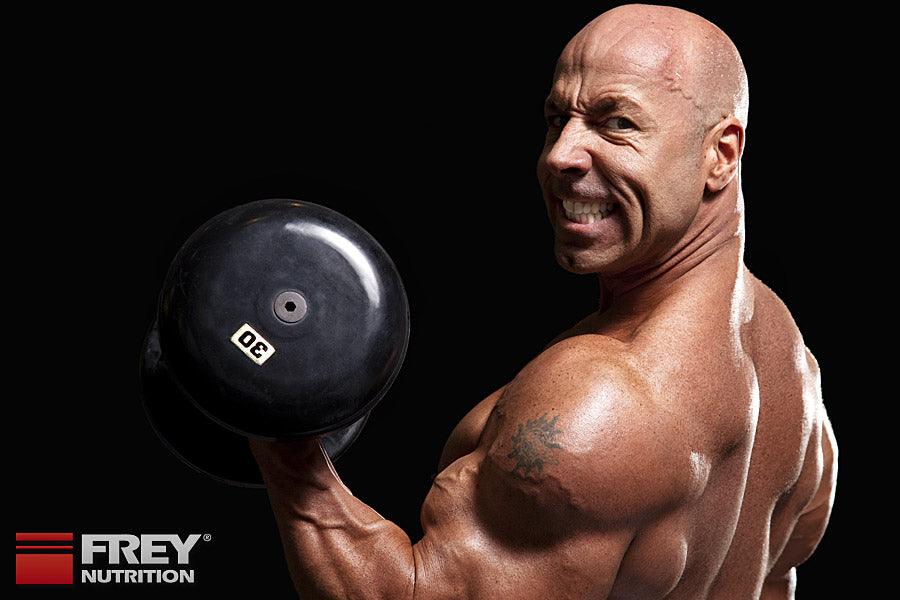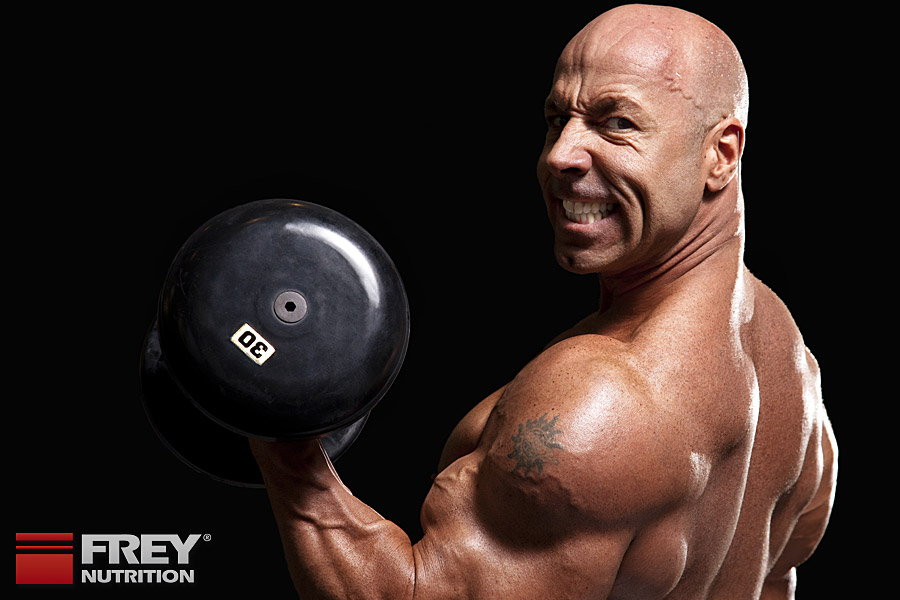SCIENTIFIC BASIS OF THE CREATIN KINASE SYSTEM
CREATINE is a substance that has been known for over 150 years. It was discovered in 1834 by the Frenchman Chevreul as a component in meat broth. In 1847, Justus von Liebig methodically and reliably demonstrated that creatine was a component in the meat of various mammal species. It is an essential ingredient in the meat extract named after him. Creatine is a substance produced by the body itself, which is partly produced in the body itself or is absorbed through food, especially meat and fish. The body of a 70 kg person contains around 100 to 120 g of this substance, mainly in the skeletal muscles, heart muscle and brain. DAILY REQUIREMENT IS APPROXIMATELY 2 TO 4 G. Creatine is a natural, biological substance that also occurs in human breast milk. (Huelsemann et al. 1987) and animal (Kennaugh et al. 1997) before.
Creatine is "charged" to the energy-rich compound phospho-creatine with the help of the enzyme creatine kinase (CK). This chemical energy is then available in the organs and cells for a variety of tasks, e.g. for the contraction of skeletal and cardiac muscles, as well as for maintaining the internal cell environment by supplying energy to ion pumps (calcium and sodium/potassium pumps). In the cell, ATP (= adenosine triphosphate) is produced at the site of energy consumption using the enzyme creatine kinase (CK) and the energy-rich phospho-creatine. This can be used in all living beings as a universal energy currency for all biological processes that consume energy.
FREY NUTRITION® ATHLETE ALEXEJ KAUZ REACHED HIS PERSONAL BEST FORM IN 2013 AND SECURED THE 2013 WORLD CHAMPIONSHIP TITLE IN THE LARGE MEN'S CLASS FOR THE FIRST TIME AFTER ANDREAS FREY. TO ENHANCE THE EFFECTS, ALEJ OFTEN COMBINES CREATINE WITH ALPHA-LIPOIC ACID AND TAKE BOTH IMMEDIATELY AFTER TRAINING WITH THE PWN.
An overview of the localization in different tissues and cells and the structure and function of creatine kinase can be found in the reference articles listed below (Bessman and Geiger 1981; Wallimann et al. 1992; Saks and Ventura-Clapier 1994; Wallimann and Hemmer, 1994; Wyss and Wallimann 1994; Wallimann et al. 1998a; Brdiczka et al. 1998) , as well as in the two papers by Molecular and Cellular Biology, Vol. 133/134 (1994) and ibid. Vol.184 (1998) (VA Saks and R. Ventura-Clapier, editors) .
Basic research has demonstrated the eminent physiological importance of the CK system and documented the role of phosphocreatine as an energy buffer, but also as a form of transport of energy in the cell (Wallimann et al. 1992) . Nevertheless, many important questions concerning the creatine kinase system in the context of cellular bioenergetics are still open and require further research (see Wallimann et al. 1998b; Schlattner et al. 1998) .
Α-LIPOIC ACID CAN INCREASE THE ABSORPTION AND EFFECTS OF CREATINE THROUGH ITS PROPERTY AS AN “INSULIN PUSHER”.
Since the creatine kinase/phospho-creatine system is found primarily in tissues and cells with high and sometimes strongly fluctuating energy turnover, such as in the skeletal and cardiac muscles, as well as in the brain, the retina of the eye and in sperm, but is also found in smooth muscles and in growing bones and cartilage, as well as in immune cells (see Wallimann et al. 1992; Wallimann and Hemmer 1994) , it is to be expected that creatine should have a positive effect, if at all, primarily in these tissues and cells. According to recent findings, this now actually seems to be the case. The fact that the creatine kinase isoenzyme family has remained structurally and functionally highly conserved during evolution from sea urchins to humans (Mühlebach et al. 1994; Eder et al. 1999) , indicates the general importance of their function in the metabolism of various organisms, organs and cells. It would therefore be quite plausible if creatine would turn out to be a universal "energy booster" thanks to its diverse applications.
POSITIVE EFFECTS ON SKELETAL MUSCULATURE
For understandable, not least commercial reasons, creatine research is most advanced in the field of performance physiology and elite sport, and the number of scientifically valuable studies directly on humans has become considerable in the meantime and is still growing.
Based on the results of basic research, various internationally known top athletes began taking creatine powder on their own about 5 years ago and achieved astonishing performance increases of 10 to 20%, initially mainly in the sprint area. (Casey et al. 1996; Hultman et al. 1996) , but also in other disciplines.
Through targeted supplementation with creatine, not only sprint performance but also endurance performance can be improved and recovery times after hard training can be shortened (Greenhaff et al. 1994: Vandenberghe et al. 1997; Aaserud et al. 1988; Brönnimann et al. 1988; Volek et al. 1999) . Creatine supplementation is therefore used successfully not only in strength sports (weight lifting, wrestling/swinging, bodybuilding, etc.), but also in athletics, team and game sports (football, ice hockey, volleyball, tennis, squash, etc.), as well as in endurance sports (cycling, triathlon, marathon and mountain running, etc.).
The fact that submaximal exercise, which depletes glycogen stores, increases both the uptake of CREATIN , as well as the accumulation of glycogen in muscle tissue significantly increases (Robinson et al 1999) shows that training in combination with creatine supplementation plus carbohydrate loading leads to optimal effects. In the subjects who consumed carbohydrates plus creatine, the glycogen stores were significantly increased compared to the subjects who only consumed carbohydrates. (Robinson et al. 1999) . The increase in glycogen stores achieved in this way also explains the positive effect of creatine on endurance performance. Training also improved the absorption of creatine (Robinson et al. 1999) . Since an increased phospho-creatine level in the muscles leads to an improvement in the energetics for calcium homeostasis, an effect of creatine on endurance performance is also to be expected from this aspect, ie the energy used for the cyclic calcium uptake by the Ca2+-ATPase pump during muscle contractions can be used more efficiently thanks to an increased phospho-creatine level.
Although it was already shown in 1976 with skeletal and cardiac muscle cells in culture that external creatine causes an increase in muscle-specific protein synthesis (Ingwall 1976) , it was long denied that creatine causes a direct increase in muscle mass, because water is also accumulated in the muscle tissue, especially during the loading phase with creatine (Francaux and Poortmans 1999) , which usually leads to a slight weight gain (1 to 2 kg). This is because the creatine transporter is a sodium chloride co-transporter (Guerrero and Wallimann 1998) and water must be absorbed into the cells for osmotic balance. That is why it is important to drink a lot during a creatine treatment, APPROX. 1 LITRE PER 20 KG BODY WEIGHT a day. However, a Finnish group who administered creatine to patients with "gyrate atrophy", an eye disease, realized early on that long-term intake of creatine (1.5 g daily for a year) was indeed accompanied by a direct increase in muscle mass, which was exclusively due to an increase in the diameter of fast type II muscle fibers. (Sipilä et al. 1981) .
DURING A CREATINE TREATMENT IT IS ESPECIALLY IMPORTANT TO ENSURE THAT YOU GET ENOUGH FLUIDS!
Further results from an Australian research group also showed that creatine supplementation over 12 weeks in conjunction with strength training can lead to a significant increase in the cross-sectional area of all fibers, including the slow type I fibers. (Volek et al. 1999) . Parallel to this muscle building, a decrease in fat tissue was often observed (Vandenberghe et al. 1997) , which leads to a desirable increase in lean body mass (Volek et al. 1999) . This secondary positive effect is certainly also important for other applications outside of the sports sector and could also be used, for example, in weight-loss programs.
WHAT SHOULD BE EMPHASIZED AGAIN AT THIS POINT IS THE FACT THAT CREATINE DEVELOPS ITS FULL EFFECTS ESPECIALLY IN CONJUNCTION WITH INTENSIVE MUSCLE TRAINING AND CARBOHYDRATE LOADING (ROBINSON ET AL. 1999) .
The following reference articles are also recommended as overview articles for the assessment and application of creatine in sports: Balsom et al. (1994); Wyss and Wallimann (1994); Greenhaff (1997); Guerrero and Wallimann (1998); Greenhaff (1997), Juhn and Tarnopolsky (1998), Plisk and Kreider (1999), Robinson et al. (1999); Volek et al. (1999) .
POSITIVE EFFECT ON THE HEART MUSCLE
While creatine supplementation in chronic heart failure did not appear to significantly increase cardiac output, leg muscle performance did improve significantly (Andrews et al. 1998) , which also contributed to an improvement in the quality of life in these patients (Gordon et al. 1995) . A significant protective function of the heart in various heart diseases was achieved by direct infusion of phosphocreatine as an additive in the cardioplegic infusion solutions. (Tronconi and Saks 1989) . This application also had a positive effect on chronic heart failure (Grazioli et al. 1992) . In addition, cardiac arrhythmias after a heart attack can be significantly reduced in the same way (Ruda et al. 1988) .
The fact that the creatine kinase system is important for the function of the heart muscle and cardiac conduction is proven by the fact that transgenic animals that produce no or very little of this enzyme in the skeletal muscle or in the heart muscle exhibit disturbances in muscle and heart function (Steeghs et al. 1996) , which are not so serious that the animals cannot survive. This can be explained by the fact that various metabolic and structural adaptations have taken place in both the skeletal muscles and the heart muscle of these animals and other energetic "safety systems" have been up-regulated. In this way, the organism can apparently at least partially compensate for the failure of the creatine kinase system. Test animals that were fed the creatine analogue, guanidinopropionic acid (GPA), a treatment that reduces the creatine level in the muscles by 80%, show clear signs of hypertrophy of the heart, as well as mitochondrial myopathies (= muscle diseases) in the skeletal muscles. When GPA, which inhibits the uptake of creatine into cells, is added to heart cells in culture, signs of mitochondrial myopathies with greatly enlarged, rod-shaped mitochondria also appear after a few days (Eppenberger-Eberhardt et al. 1991) in which mitochondrial creatine kinase is crystallized into regularly arranged intramitochondrial inclusions (Gorman et al. 1997a) , a typical appearance for mitochondrial diseases. After adding creatine to the cell culture medium, these inclusions disappeared and the size of the mitochondria returned to normal. It has not yet been shown whether these inclusions also disappear in patients taking creatine, but significant improvements in muscle strength have been observed in such patients. (Hagenfeld et al. 1994; Tarnopolsky et al. 1997) . In the field of cardiology, however, the potential of creatine is far from being exhausted and interesting, long-term effects can be expected, e.g. for the prevention of certain heart diseases and their mitigation.
CREATINE IS ALSO IMPORTANT FOR SLOW, SMOOTH MUSCULATURE
The creatine kinase system is also important for the cellular energetics of the relatively slow contraction of smooth muscles in the body (Wallimann and Hemmer 1994) . The enzyme and the corresponding substrates, creatine and phosphocreatine, are found in the smooth muscles of the blood vessels (Clark et al. 1994) , the gastrointestinal tract (Ishida et al. 1995) , as well as in the uterus (Clark et al. 1993) where they also play an important role in the energy supply for the function of these muscles (Takeuchi et al. 1995) .
The assumption that creatine supplementation could also have a positive effect on smooth muscles is supported by the fact that various patients with muscle wasting often noticed improved bowel function, better bladder control and better blood circulation as "side effects" of creatine treatment and also often had noticeably warmer extremities.












